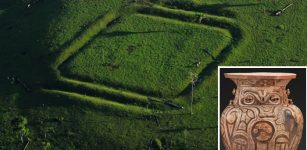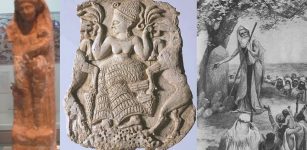‘Cradle Of The Scythians’ Studied By Russian-Polish Archaeologists
The necropolis, in which Great Steppe nomads were buried 2500 years ago, consists of over 100 mounds and each of them contains a single skeletal grave.

Artist's impression of how a Scythian funeral process may have looked like. A typical Scythian burial mound (or kurgan) is visible in the background. credits: ancient.eu.
"This year we conducted excavations within three mounds covered with stone embankments. Unlike most objects surveyed in previous seasons, this time the graves almost completely lacked equipment,” Łukasz Oleszczak of the Institute of Archaeology, Jagiellonian University in Kraków, who heads the Polish team, said.
See also:
Mysterious Disappearance of Scythians Remains Unsolved
Buried in the tombs are nomads who inhabited the belt stretching from the Altai to the steppes of Eastern Europe from the fifth to the third century BC.

"The Scythians terrorized eastern Europe 2.5 thousand years ago - traces of their invasions in the form of burnt settlements and characteristic three-cornered arrowheads made of bronze, are clearly visible also during excavations carried out in Poland."
The researchers believe, the place is the cradle of Scythian, militant and nomadic cultural model.
The Scythians terrorized eastern Europe 2.5 thousand years ago, reports Science and Scholarship in Poland. The traces of their invasions in the form of burnt settlements and characteristic three-cornered bronze arrowheads made are clearly visible also during excavations carried out in Poland.
Additionally, archaeologists carried out minor excavations in the alpine terrain of the Altai, on the slopes of the Kurai ridge and unearthed
"Just a few meters from one of the studied mounds we have found a fallen stone stele, oblong boulder with the function of a monument, referred to as balbal by Russian archaeologists. This type of installation often accompanies sepulchral objects from the Iron Age in the Upper Altai,” Oleszczak said.

Removing boulders from mounds often requires significant effort of all expedition members. Photo by Ł. Oleszczak
Archaeologists have also carried out minor excavations in the alpine terrain of the Altai, on the slopes of the Kurai ridge and unearthed “16 mounds with perimeters reinforced with stone wreaths, some of which had slumped," as Oleszczak explained.
Based on the construction and layout of the mounds archaeologists speculate that the mounds date back approximately 2500 years and were erected by the same community as the mounds near Mangerok.
Excavations will continue next year.
The Scythians are believed to have originated from the Central Asian region of Persia, as a branch of the ancient Iranian peoples expanding north into the steppe regions from around 1000 BCE. The Scythians first appeared in the historical record in the 8th century BC.
AncientPages.com





















